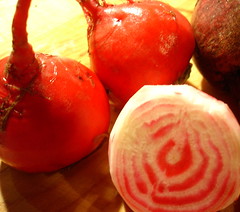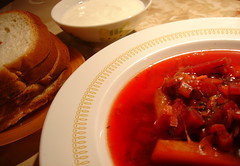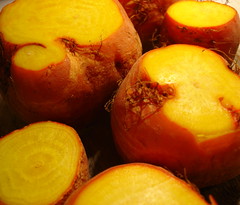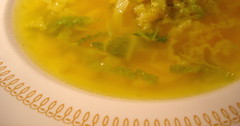Not Your Baba's Borscht
 fig. a: beets, candy-striped and otherwise
fig. a: beets, candy-striped and otherwise
Don't get me wrong: there's nothing wrong with your Baba's borscht and the recipes that follow are by no means some kind of rejection of the fine tradition of borscht-making that extends across Poland, the Ukraine, Russia and beyond. As you'll see in a few months when we print an authentic Baba-approved recipe for a hearty winter borscht (and as should be obvious to anyone who's followed "...an endless banquet" over the last couple of years), we're big fans of those time-tested recipes that have been passed down from generation to generation. It's just that personally I can't lay claim to a borscht-making lineage--my Baba was Slovak and therefore didn't make borscht, even though pickled beets were a staple of her table--and so my take on borscht might strike some as unorthodox. Not disrespectful, just a bit different. For one thing, I've never made a borscht that wasn't meat-free. This is because I started making borscht back when I was a vegetarian and I quickly learned that the combination of onions, garlic and beets makes one heck of a broth, and quickly, too. If I want a borscht that's more of the stick-to-your-bones variety I just make it chunkier, I bump up the potato content, and I add some extra dairy to the mix. In the fall, however, I tend to crave a borscht that's lighter on the palate, one that's got a clear broth that really highlights just how flavorful and attractive beets are at this time of year when they're at their peak. Since discovering heirloom varieties of beets, like white beets and golden beets, a few years ago, I've tried to make sure to make at least one borscht per harvest season that takes advantage of the best heirloom varieties I can get my hands on. I don't fetishize heirloom beets, but if I have the option to buy golden beets over your standard beet-red beets (especially when they're more or less the same price), I will. Two years ago I made an extraordinarily sweet borscht using white beets and white carrots, both heirloom, and both very inexpensive because I'd picked them up from our friend Patrice. This year, over the last couple of weeks, I've made two of these specialty borschts.
For the first of these I used the gorgeous candy-striped specimens that you see in the photo above. I avoided using cabbage altogether, and only included potatoes to make the broth (I took them out when the broth was done). The carrots, the copious amounts of dill, and the dollop of sour cream that came with each bowl added a bit of familiarity, but those candy-striped beets made for one of the most striking borschts I've ever seen.
Borscht I
1 tbsp canola oil
1 onion, minced
1 clove garlic, minced
1 medium-size leek, cleaned and chopped finely
5-6 medium beets (the nicest ones you can find), peeled and diced
6-8 cups water
2 carrots, peeled and chopped into 2-inch long sticks
4 small potatoes, peeled but otherwise left whole
1/4 cup finely chopped fresh dill
salt and pepper to taste, making sure to pepper the borscht assertively
sour cream (garnish)
Heat you oil in a large pot over medium heat. Add your onion and sauté for a couple of minutes. Add the garlic and leek and continue to sauté over medium heat until the onions have started to become translucent and the leek is wilted and flavorful. Add the beets and sauté for a minute or two. Add the water, the carrots, and the potatoes and bring to a boil, then simmer for 30 minutes. Remove the potatoes and save them for another purpose [like making some outrageously flavorful pink homefries the next morning for breakfast]. Add the dill and simmer for another 5 to 10 minutes.
 fig. b: borscht with candy-striped beets
fig. b: borscht with candy-striped beetsServe in bowls that will show off the beautiful color of the broth as much as possible with a dollop of sour cream and plenty of good, fresh bread (like a baguette, a sourdough, or, better yet, a pumpernickel, rye, or challah loaf).
 fig. c: golden beets
fig. c: golden beetsBorscht #2 was made with the lovely golden beets you see above. The broth was even lighter this time around because I didn't use any potatoes at all. I did add cabbage this time around, but I went with just a little bit of Savoy cabbage instead of your standard green or red cabbage. This may have been the sweetest broth I've ever made, right up there with that all-white borscht mentioned above. The golden beets gave it the most beautifully delicate flavor--then I added the cabbage and ten minutes later the broth had become even sweeter and mellower. I loved its pale yellow color, which brought to mind fallen leaves.
Borscht II
1 tbsp butter
1 onion, minced
2 cloves garlic, minced
2 small leeks, cleaned and chopped
4-5 medium beets
6 cups water
salt and pepper to taste, making sure to pepper the borscht assertively
1/4 head savoy cabbage, chopped into a fine shred
sour cream (garnish)
Melt the butter over medium heat in a large soup pot, being careful not to let it scorch. Add the onion and sauté for 1 or 2 minutes. Add the garlic and leeks and sauté for about 10 minutes, or until the onions are becoming translucent and the leeks have wilted and become flavorful. Add the beets and the water and bring to a boil, then simmer for 30 minutes. Adjust the seasoning and add the cabbage. Simmer for another 10 minutes.
 fig. d: golden beet borscht with savoy cabbage
fig. d: golden beet borscht with savoy cabbageAgain, serve so as to show off the borscht's beautiful color. Add a dollop of sour cream to each serving. Have plenty of good bread on hand.
Both of these borschts are quick, easy, inexpensive, and vegetarian. More importantly, they're phenomenally tasty. Make them with some exceptional beets--like the candy-striped beets we got from Jacques et Diane at Jean-Talon Market, or the golden beets we got from Patrice--and they might very well be the best borschts you've ever had. Other than your Baba's, that is.
aj










3 comments:
AJ, Thanks for reminding that borsch does not have to contain meat and cabbage to be good. My Russian Baba could not cook (Noblesse oblige!) but Mom used to do a mean cabbage-veal shanks borsch; I continue in her footsteps but sometimes prefer a lighter version.
PS: apart eating borsch with dark bread, I always serve alongside molossol dill pickles and a shot of vodka.
Those beets look great! Any advice on what to include in a borscht made with only the regular kind?
Hi Matthew,
both of those recipes will work just fine with regular beets. I like to do a clear-broth borscht with red beets that also includes strips of wild mushrooms. I find they give borscht a nice deep flavor--one that's unexpected in a clear-broth version. Like I said, stay tuned for a hearty, traditional recipe. We're going to wait until it's really cold out to post it, but, looking out my window, it's snowing here at the moment, so we may be posting that recipe sooner than I thought.
Hi Alexis,
Veal shanks sounds like an amazing addition. I'll have to work on that one.
I like your style: we had Borscht #1 with Michelle's new batch of dill pickles (her best yet) and a couple of shots of vodka.
Post a Comment